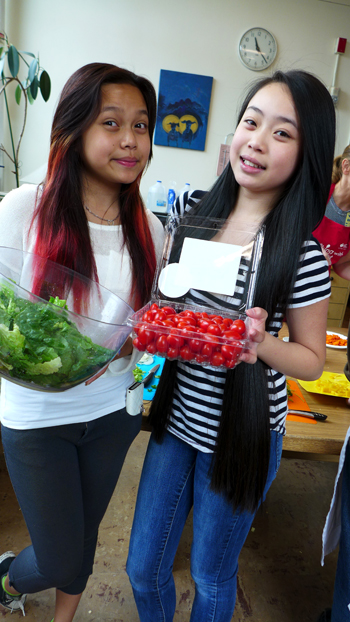
Students Cheryl Nguyen, left, and Helen Nguyen prepare healthy meals.
By Francesca Fabile Minas
Special to Northwest Asian Weekly
There is a lot of talk these days about helping kids eat healthier foods, especially as the United States faces a serious obesity problem, in both children and adults. Childhood obesity has more than tripled over the past 30 years, putting more children at risk for heart disease and other chronic health conditions.
Studies have shown that kids who help prepare meals at home are more likely to eat nutritious foods, along with more fruits and vegetables. The American Heart Association wrapped up its Kids Cook with Heart program at two middle schools in Lynnwood and Seattle earlier this year. Kids Cook with Heart was developed as a childhood obesity prevention strategy.
The main goal was to empower students to construct a healthy meal by providing hands-on experience. The kids learned basic cooking skills using a variety of healthy foods and seasonings, along with general strategies for planning healthy meals and snacks. “Hands-on instruction is so important for building confidence and allowing students to take ownership of the finished food creation,” said Amy Reuter, the Kids Cook with Heart facilitator and CEO of Seattle Food Nut.
Reuter taught the students about food safety, focusing on proper hand washing, knife handling, and a different cooking method every week. With each lesson, the kids had to prepare a recipe and then taste them at the end. Among the dishes they prepared were turkey tortilla soup, a breakfast burrito, chickpea salad, Szechuan chicken stir-fry, and lighter fettuccine alfredo.
“I was amazed at the interest, collaboration, and courage that these students displayed while practicing new culinary skills and tasting unfamiliar foods,” said Reuter.
Are you ready to start teaching your children how to cook? According to Reuter, “Allowing kids to help in the kitchen can start as young as age 4, with activities such as measuring ingredients and mixing them together. More advanced skills, including slicing and dicing, can be introduced generally in the 10 to 12 age range, and around 12 to 14 for sautéing, stir-frying, and removing food from a hot oven.”
Getting kids involved in cooking and planning meals has other benefits. It helps them develop good eating habits and spend quality time with the family. Meals prepared at home are more likely to be healthier and can help increase their consumption of fruits and vegetables. Cooking with your children can also be a great way to introduce unfamiliar foods or foods prepared in a different way.
The American Heart Association has additional tips to help the family eat healthier:
— Enjoy meals together. When everyone sits down together to eat, there’s less chance of children eating the wrong foods or snacking too much.
— Eating healthier at home starts with the ingredients you use. Many favorite recipes can be made healthier by substituting with healthier ingredients.
— Limit added sugars in your family’s diet. Sugar-sweetened beverages are the largest source of added sugars for most people, so reduce or cut out soda, sports drinks, energy drinks, and fruit drinks, as well as enhanced waters, sweetened teas, and sugary coffee drinks. Drink more plain water instead.
— Add them to dishes your family already loves and use them as healthier sides, snacks, and desserts. If you choose canned foods, watch for added sodium and sugars.
Throughout the Kids Cook with Heart program, some of the kids were a little bit afraid to try unfamiliar foods they had cooked. But the ones who gave it a taste ended up liking them. The best feedback, however, was when kids would comment that the biggest lesson they learned was that healthy food can be delicious. Mission accomplished!
To learn more about nutrition and look up healthy recipes, visit www.heart.org/simplecooking. (end)
Francesca Fabile Minas is the senior director of communications and marketing for the American Heart Association Western States Affiliate in Seattle.



